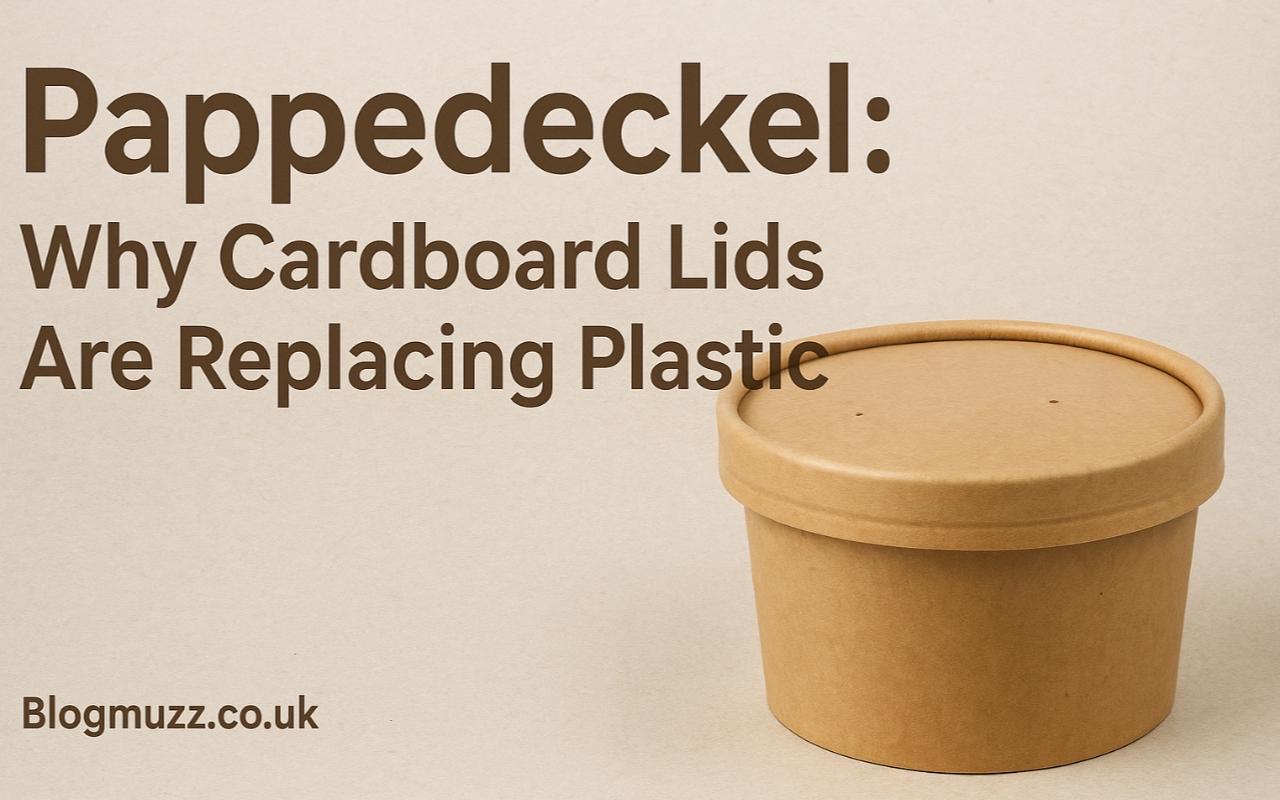In recent years, one small product has quietly become a symbol of sustainability and innovation — the pappedeckel, or cardboard lid. Once considered a minor accessory for coffee cups and takeaway beverages, the pappedeckel is now at the heart of a global shift toward eco-friendly materials and circular design. As governments, businesses, and consumers become increasingly aware of plastic pollution and climate impact, the simple pappedeckel is taking center stage as a smart, sustainable alternative to conventional plastic lids.
In this article, we’ll explore what a pappedeckel is, why it matters, how it’s made, and why it’s replacing plastic lids across industries. From its environmental benefits to design innovation, this detailed guide dives deep into the rise of the cardboard lid revolution.
What Is a Pappedeckel?
The German word “pappedeckel” literally translates to “cardboard lid” in English. It refers to a paper-based or fiber-based cover typically used for disposable cups, containers, and food packaging. These lids are designed to fit snugly over cups, keeping beverages warm and preventing spills — just like their plastic counterparts, but with one critical difference: they’re made from renewable, biodegradable materials.
Modern pappedeckel products are engineered using compressed paperboard, plant fibers, or biodegradable pulp. Many are coated with natural wax or water-based barriers to enhance durability without compromising compostability. This innovation allows them to withstand heat, moisture, and movement — making them practical for both hot and cold drinks.
Over the last decade, the demand for pappedeckel lids has surged, especially in Europe. The European Union’s ban on single-use plastics has pushed manufacturers, coffee chains, and packaging companies to develop sustainable alternatives. The result is a growing market for pappedeckel lids that look sleek, perform well, and protect the planet.
The Environmental Problem with Plastic Lids
Before understanding the benefits of pappedeckel, it’s important to see the issue it’s solving. For decades, plastic lids — typically made from polystyrene (PS) or polypropylene (PP) — dominated the takeaway beverage market. These materials are cheap, light, and easy to mold, but they come with severe environmental drawbacks.
Plastic lids are non-biodegradable and can take hundreds of years to break down. Even then, they fragment into microplastics, contaminating oceans, soil, and food chains. According to environmental studies, millions of tons of plastic waste are generated every year from disposable coffee cups and lids alone.
Recycling is not a viable solution for most plastic lids. Their small size, mixed material composition, and contamination with beverage residue make them difficult to collect and process. Consequently, billions of lids end up in landfills or natural environments every year.
The pappedeckel directly addresses this challenge by offering a renewable, compostable, and recyclable alternative. Its development represents a critical step in the global mission to eliminate single-use plastics and promote a circular economy.
How Pappedeckel Lids Are Made
The manufacturing process of a pappedeckel combines engineering precision with environmental consciousness. Unlike petroleum-based plastic lids, which are created from fossil fuels through chemical extrusion and molding, pappedeckel lids start with natural, renewable resources — mainly wood pulp or recycled paper fibers.
Here’s a simplified overview of how pappedeckel lids are made:
- Material Sourcing: Manufacturers source certified paper pulp or recycled cardboard. Sustainable producers often use FSC (Forest Stewardship Council) certified wood fibers.
- Pulp Preparation: The raw paper is mixed with water to form a pulp, sometimes reinforced with biodegradable binders for strength.
- Molding & Pressing: The pulp is molded into the shape of a lid using high-pressure forming machines. This step gives the pappedeckel its structure and tight-fitting design.
- Drying & Coating: Lids are dried and coated with a natural, food-safe layer — often plant-based wax or a biodegradable polymer — to resist moisture and heat.
- Quality Control & Packaging: Finished pappedeckel lids are tested for fit, durability, and compostability before being packed for distribution.
The result is a lightweight, robust, and eco-friendly lid that performs almost identically to a plastic one — without the environmental cost.
Why Pappedeckel Is Replacing Plastic
There are several compelling reasons why pappedeckel lids are rapidly replacing plastic in cafés, restaurants, and packaging industries:
1. Sustainability and Biodegradability
The most obvious advantage is that pappedeckel lids are biodegradable. Made from organic fibers, they can decompose naturally within weeks or months, depending on conditions. Unlike plastic, which lingers for centuries, a pappedeckel returns to the earth as part of the natural cycle.
2. Regulatory Compliance
Governments around the world — especially within the European Union — have enacted strict bans on single-use plastics. This legislation has forced companies to find alternatives. Pappedeckel lids not only meet these legal requirements but also demonstrate a brand’s commitment to sustainability.
3. Consumer Demand
Modern consumers are eco-conscious. Studies show that customers increasingly prefer brands that prioritize sustainability. When a coffee shop uses pappedeckel lids instead of plastic, it sends a powerful message that resonates with environmentally aware audiences.
4. Recyclability and Compostability
In many regions, pappedeckel products can be composted at home or processed in industrial composting facilities. Some designs are even recyclable alongside paper waste. This closed-loop potential makes them far more sustainable than any single-use plastic alternative.
5. Corporate Social Responsibility
For businesses, adopting pappedeckel lids is part of a larger corporate social responsibility (CSR) strategy. It’s a simple yet visible action that aligns with sustainability goals and improves brand reputation.
Design and Innovation in Pappedeckel Technology
Gone are the days when eco-friendly products meant compromising on quality or appearance. Modern pappedeckel lids are the result of innovative engineering and design.
Manufacturers have improved structural integrity to prevent leaks and warping. Some lids include heat-resistant lamination, air vents for pressure control, and ergonomic sipping designs for a comfortable drinking experience. High-end pappedeckel lids can even mimic the smooth texture of premium plastic — without any petroleum content.
Technological advances have also made it possible to print brand logos or color designs directly on pappedeckel surfaces using eco-friendly inks, allowing cafés and businesses to maintain strong branding while staying sustainable.
Furthermore, companies are experimenting with molded fiber composites, combining recycled paper fibers with plant starches for enhanced water resistance. These innovations are making pappedeckel lids more durable, affordable, and appealing to both businesses and consumers.
Economic Benefits of Switching to Pappedeckel
At first glance, switching to pappedeckel lids might seem more expensive than sticking with plastic, but when you look at the total economic picture, the advantages are clear.
- Avoiding Fines and Compliance Costs: Businesses that continue using banned plastics risk fines or penalties in many regions. Switching early helps avoid these costs.
- Brand Differentiation: Consumers associate eco-friendly practices with quality and integrity. Using pappedeckel lids can attract loyal customers and justify slightly higher prices.
- Supply Chain Opportunities: As demand for sustainable materials grows, suppliers of pappedeckel products benefit from stable, future-proof business opportunities.
- Long-Term Savings: As production scales up, the cost of pappedeckel manufacturing is steadily decreasing. Bulk production and technological improvements are bringing prices close to parity with plastic lids.
In essence, pappedeckel lids are not just environmentally sound — they’re economically strategic.
Global Adoption of Pappedeckel Lids
The shift toward pappedeckel is not limited to Germany or Europe. Across the globe, coffee chains, packaging manufacturers, and fast-food brands are embracing paper-based lids as part of their sustainability goals.
In Scandinavia, several coffee franchises have replaced all plastic lids with fiber-based ones, supported by strong recycling infrastructure. Australia and New Zealand have introduced national initiatives promoting compostable packaging. Even in the United States, where plastic use remains high, major brands like Starbucks and McDonald’s are testing or rolling out paper-based lid solutions.
The movement is accelerating because it aligns with a broader sustainability agenda: reducing carbon footprints, eliminating single-use plastics, and promoting renewable materials. The pappedeckel fits perfectly into this global vision.
Challenges and Future of Pappedeckel Production
While the pappedeckel revolution is promising, it’s not without challenges. The main issues include costs, moisture resistance, and recycling confusion.
Some consumers still dispose of pappedeckel lids incorrectly, assuming they belong with plastics. Public education and standardized recycling labels are essential to solve this. Manufacturers are also working to improve water resistance and heat tolerance without adding synthetic coatings, which can compromise compostability.
The future looks bright, though. New materials like seaweed-based coatings, sugarcane fiber, and biopolymer composites are being tested to make pappedeckel lids even more functional and sustainable. As these technologies mature, production costs will continue to drop, and adoption will accelerate worldwide.
How Consumers Can Support the Change
Consumers play a crucial role in the shift from plastic to pappedeckel. Here’s how everyone can contribute:
- Choose cafés that use pappedeckel lids. Your purchase decisions send a strong message to businesses.
- Dispose of lids correctly. Check local recycling or composting rules to ensure they end up in the right waste stream.
- Spread awareness. Educate friends and colleagues about why pappedeckel lids matter.
- Support sustainable brands. Look for certifications like FSC or compostable packaging labels when shopping.
Small daily choices create large-scale impact. Each pappedeckel lid used instead of plastic prevents unnecessary waste and supports a healthier planet.
Conclusion: The Future Belongs to Pappedeckel
The rise of the pappedeckel reflects a broader truth about our time — sustainability is no longer optional. What began as a minor adjustment in takeaway packaging has evolved into a global movement symbolizing innovation, responsibility, and environmental awareness.
From its renewable materials to its biodegradability, the pappedeckel demonstrates how thoughtful design can replace outdated, harmful practices. Businesses adopting these lids not only comply with regulations but also build stronger relationships with eco-conscious customers. Consumers, on the other hand, have the power to accelerate this change through their everyday choices.
In the end, the humble pappedeckel is more than just a coffee lid — it’s a statement of intent, a commitment to a greener future, and a reminder that even the smallest decisions can lead to meaningful global impact.



